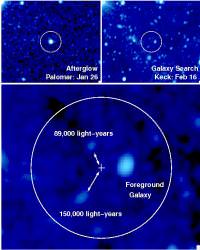Written by Fraser Cain

When astronomers find a gamma ray burst, they can usually locate the culprit's home galaxy. But in the case of an explosion that went off earlier this year, there's no galaxy to be found - even with the most powerful telescopes on Earth.
The gamma ray burst GRB 070125 was first detected on January 26th, 2007 by NASA's Swift telescope in the constellation Gemini. One of the brightest bursts of the year, astronomers scrambled to observe the explosion and then the slowly fading afterglow.
Gamma ray bursts occur when a massive star runs out of fuel. Without the light pressure, the star collapses inward on itself, turning into a black hole. This newly formed black hole spins at an enormous rate, generating enormous magnetic fields. These fields catch infalling material and spew it out again into powerful jets. And it's those jets where the burst comes from.
One of the normal activities in observing GRBs is the identify the host galaxy so that astronomers can measure its distance. It's also important to know what kind of galaxy the burst exploded within to better understand the kinds of environments can lead to these massive stars.
In the case of GRB 070125, though, no originating galaxy was obvious. Astronomers from Caltech/Penn State used the 60-inch Palomar Observatory to watch the afterglow, and then called in the even larger Gemini North and Keck 1 telescopes, located on Hawaii's Mauna Kea.
Even with the power of Keck, they couldn't find a galaxy.
So how could you get a gamma ray burst without a galaxy? Astronomers know that colliding galaxies can throw off enormous tidal tails that stretch away for hundreds of thousands of light-years. The original star could have been within one of these tidal tails, many light-years away from its parent galaxy.
If their theory is correct, a long duration exposure from the Hubble Space Telescope should reveal the dim tidal tail.
Original Source: NASA News Release



No comments:
Post a Comment